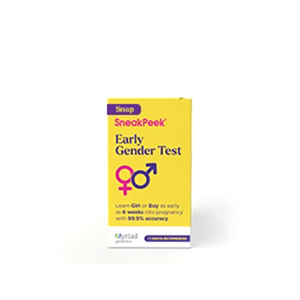Published on October 27th, 2022 and Updated on April 19th, 2024
Check out SneakPeek Gender Test to find out your baby’s gender as early as 6 weeks at over 99% accuracy1!
Upon finding out you’re pregnant, there can be a myriad of emotions—excitement, shock, and amazement, to name a few.
In contrast, when a miscarriage happens, the onslaught of conflicting feelings like confusion, regret, and heartache can be overwhelming, causing immense grief for your baby and the future you had planned in stages like that of early pregnancy.
After some time to heal, one may wonder —how soon after a miscarriage can you get pregnant?
Scientifically speaking, if you begin having unprotected sex after the recommended waiting period of two weeks, it’s possible to become pregnant just a few weeks after your miscarriage.
When to Try to Get Pregnant Again
According to the latest news regarding topics like pregnancy and early pregnancy loss, If you’ve recently gone through a miscarriage, there’s no one-size-fits-all answer regarding when to start trying to conceive again.
In one 2017 study, couples who began trying for a successful pregnancy immediately after a miscarriage showed no increased risk of pregnancy loss. However, depending on your circumstances and what medical advice your healthcare provider may recommend, some say it is best to wait a period of time before actively trying to get pregnant.
Factors to consider when deciding when to conceive again:
#1 Your hCG Levels
hCG, or human chorionic gonadotropin, is the hormone responsible for alerting your body that you’re pregnant. Once an embryo has implanted, elevated hCG levels can be found in urine and blood, which is why pregnancy tests look for this hormone to determine if you’re pregnant.
During and after a miscarriage, however, your hCG levels slowly drop until they’ve returned to pre-pregnancy levels (less than five milli-international units per milliliter (mUI/mL)).
Some doctors recommend that you wait until your hCG levels have lowered to less than five mUI/mL because this gives your uterine lining time to return to normal. Once your hCG levels are lower, your womb may be more receptive to receiving and nurturing a newly fertilized embryo.
Additionally, there are two other reasons why you may want to wait until your hCG levels have stabilized:
- You could receive a false positive on a pregnancy test – If you start having sex after the recommended two weeks after miscarriage, you could still have a raised level of hCG in your body. If you believe you might be pregnant and then take a pregnancy test, it can show a false positive result because your hCG levels are still elevated from the first pregnancy. If you’re wondering how soon a pregnancy test will read positive, this could make it difficult to determine whether you’re pregnant.
- A doctor may incorrectly read your hCG levels if you become pregnant again – If you become pregnant soon after your miscarriage (it is possible to conceive two weeks after miscarrying), it may be more challenging for a doctor to correctly read your blood tests. They may notice falling hCG levels and mistakenly assume you’re having another miscarriage.
The amount of time it takes for your hCG levels to normalize often depends on how far along in your pregnancy you were when the miscarriage occurred. Typically, it takes anywhere from one to nine weeks for hCG levels to return to 5 mUI/mL or lower.
#2 Whether This Is Your First Miscarriage
Another factor to consider before trying to get pregnant again is whether you’ve experienced more than one pregnancy loss. It’s recommended that women with a history of miscarriage only begin trying again after they’ve worked with their OBGYN to get a fuller picture of their clinical health and projected pregnancy outcomes.
Your doctor may suggest further testing if you’ve suffered two or more miscarriages before. This can help them determine if there are any underlying causes leading to pregnancy loss, like:
- Auto-immune disorders
- Uterine abnormalities
- Chromosomal abnormalities in your embryo
The silver lining is that most women who’ve had a miscarriage won’t find themselves faced with another: only 1% of women experience multiple miscarriages.
For women who have experienced a recurrent miscarriage, there’s a hopeful light at the end of the tunnel for you, too. Approximately 75% of women that have experienced two or three miscarriages are still able to carry a pregnancy to term and welcome their beautiful baby into the world.
#3 Whether You’ve Given Yourself Time to Process
Many women who’ve experienced the physical, mental, and emotional costs of a miscarriage understand that it can take time to grieve the loss of the future you planned for yourself and your baby.
Some women will be ready to try again in a month, while others may still need time after 6 months—and that’s alright.
If you’re seeking productive ways to process before trying to get pregnant again, many women find solace and healing by:
- Speaking with a mental health counselor – Sometimes it’s helpful to work through your feelings with a professional. Therapists, counselors, or spiritual authorities can offer various techniques to help you through the grieving process. From journaling to finding ways to mourn with your partner, talking to a mental health professional may help you sort through your emotions so you can feel emotionally prepared to try again.
- Practicing self-care – It may be tempting to stop caring about yourself, but it’s important to take care of your body to let yourself recover mentally and physically. If you’re hoping to get pregnant again, it can help to write a list of simple ways you can prioritize self-care: eating nourishing meals, spending time in nature, and taking time for movement through gentle exercise can all help you reconnect with your body.
- Remembering the silver lining – We said it once, but we’ll say it again: the odds you’ll eventually bring a baby into the world are high. Some 85% of women who’ve experienced one miscarriage eventually have healthy pregnancies and become mamas to adorable, healthy babies.
#4 Whether You’ve Had a Post-Miscarriage Menstrual Cycle
One more factor to consider before trying to become pregnant again is whether you’ve had a period since your miscarriage, and if you can get pregnant on your period. Most women have a menstrual cycle 4 to 6 weeks after a miscarriage, while others find that it arrives some 2 to 3 months after.
Often, a woman’s first period after a miscarriage is shorter or longer than usual. In some cases watery period blood is even a sign of pregnancy. If she becomes pregnant during this time, it can be challenging for a doctor to date the conception of the pregnancy. However, conceiving before having a period does not mean you’re more likely to miscarry again. It may just take a little longer to determine when you conceived.
How to Support Conception and a Healthy Pregnancy After a Miscarriage
After you’ve been cleared by your doctor and you feel ready to try again, the good news is that the rules for getting pregnant haven’t changed. Even though factors like secondary infertility following miscarriages are to be considered, tracking your ovulation, keeping stress levels low, and, of course, getting busy in the bedroom can all greatly increase your chances of becoming pregnant.
If you find that you’re not pregnant after the first month or two of trying, keep on keeping on. Most couples trying to conceive will become pregnant within six months to a year of trying. Seeking out a fertility specialist is always an option as well.
And once you do discover you’re pregnant again? You may find yourself managing a roller coaster of emotions, from complete elation to anxiety. Since numerous causes could lead to a miscarriage (from fetal chromosomal issues to chronic health conditions in moms), speaking to your MD about your health history may help illuminate specific steps you can take to support your baby’s well-being in utero.
For many women, laying the foundation for a healthy pregnancy simply means getting proactive about their own health. This could look like:
- Taking prenatal vitamins – Prenatal vitamins are loaded with two very important ingredients for the development of your growing babe: folic acid (which helps prevent abnormalities of the brain and spinal cord) and iron (which helps the placenta and baby develop).
- Eating regular, balanced meals – With the potential of morning sickness, it’s not always easy to drum up an appetite in those first few months. But if the baby requests pizza for dinner and breakfast—eat the pizza. If you can squeeze in a salad on the side for added vitamins and minerals, all the better.
- Taking it easy – If you have the energy for a light exercise, go for it! But if you feel exhausted and want to lie down, that’s okay too. Listen to your body—not only does it know how to take care of you, but it knows how to take care of your growing little one.
Build a Bond with Your Soon-To-Be-Baby with SneakPeek
Deciding when to get pregnant after a pregnancy loss is a big decision, but once you’re in, it can be tremendously rewarding—especially when you find out you’re expecting. Along with the many other questions you and your partner will excitedly discuss in those early days of pregnancy, you’ll inevitably arrive at an age-old question: do you think it’s a girl or a boy?
With the SneakPeek Early Gender Blood Test, you don’t need to wait for your 20-week ultrasound to find out. Instead, you can determine your baby’s gender from the comfort of your home as early as 6 weeks into your pregnancy. SneakPeek is the #1 OBGYN-recommended at-home gender test, clinically proven to offer over 99% accuracy1 to new parents.
Waiting nine long months to meet your tiny bundle can feel like an eternity. Join over 1 million moms who’ve used SneakPeek Test and start connecting in those precious early weeks.
This post has been reviewed for accuracy by the following medical professional:
Katie Smith is a seasoned Certified Nurse Midwife and a nurturing mother to six children, offering a unique blend of professional expertise and personal experience. She is the founder of Birth Your Way Midwifery and Women’s Wellness Center in Bay County, Florida. Katie's comprehensive approach to care is informed by her hands-on experience in motherhood and her passion for empowering women through their birthing journey. Her dedication extends beyond her center as she actively engages in community wellness and family health education.
Sources:
- Obstetrics & Gynecology. Interpregnancy Interval After Pregnancy Loss and Risk of Repeat Miscarriage.https://journals.lww.com/greenjournal/Abstract/2017/12000/Interpregnancy_Interval_After_Pregnancy_Loss_and.18.aspx
- Mount Sinai. HCG blood test – quantitative. https://www.mountsinai.org/health-library/tests/hcg-blood-test-quantitative
- Mayo Clinic. Pregnancy After Miscarriage: What You Need to Know. https://www.mayoclinic.org/healthy-lifestyle/getting-pregnant/in-depth/pregnancy-after-miscarriage/art-20044134
- Parents. All About Pregnancy After Miscarriage. https://www.parents.com/getting-pregnant/trying-to-conceive/conceiving-after-miscarriage/
- Very Well Family. How Long Until hCG Falls to Zero After Miscarriage? https://www.verywellfamily.com/how-long-until-hcg-falls-to-zero-after-miscarriage-2371511
- Washington University Physicians. Recurrent Pregnancy Loss. https://fertility.wustl.edu/getting-started-infertility/multiple-miscarriages/
- Tommy’s. Trying Again After a Miscarriage. https://www.tommys.org/baby-loss-support/miscarriage-information-and-support/trying-again-after-miscarriage
- Healthline. How Long Does It Take to Get Pregnant? https://www.healthline.com/health/pregnancy/how-long-does-it-take-to-get-pregnant
- Mayo Clinic. Prenatal vitamins: Why they matter, how to choose. https://www.mayoclinic.org/healthy-lifestyle/pregnancy-week-by-week/in-depth/prenatal-vitamins/art-20046945

Shop Our Products
SneakPeek aims to provide the most accurate and up-to-date information to help our readers make informed decisions regarding their health before, during, and after pregnancy. This article was written based upon trusted scientific research studies and/or articles. Credible information sources for this article are cited and hyperlinked.






